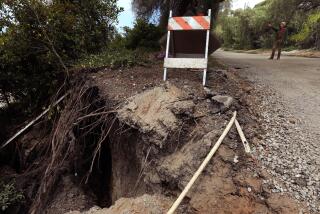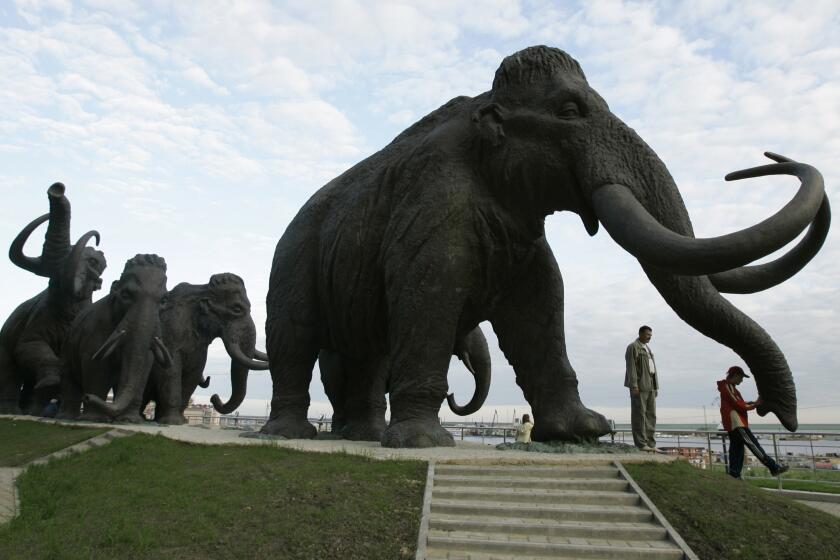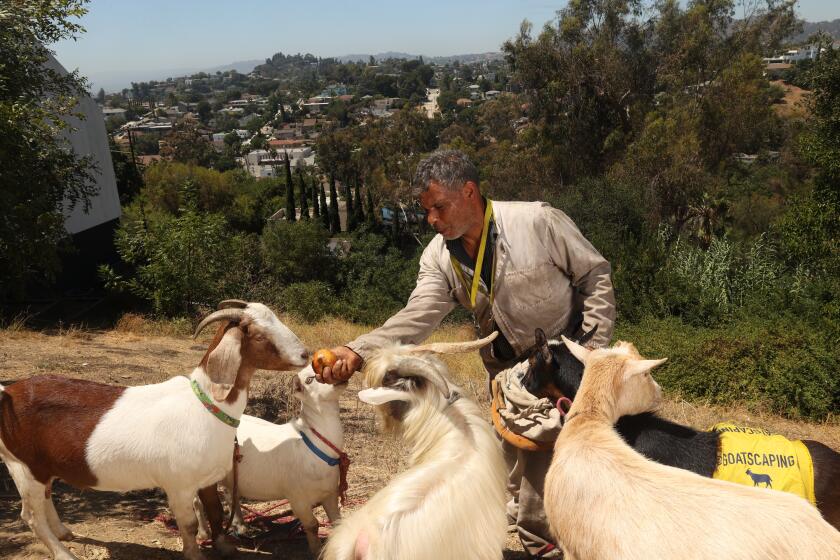Dinosaur Skeleton Found at Carlsbad Site
The largest collection of dinosaur fossils ever found in Southern California has been unearthed at a Carlsbad construction site, scientists say.
Paleontologists from the San Diego Natural History Museum believe that the dinosaur--estimated to be 15 feet long--may be the first of its kind found west of the Rockies, based on study of a small tooth taken from the site.
The scientists say a leaf-shaped tooth is common among nodosaurs (a group of armored dinosaurs), the pachycephalosaurus (known as the bone-headed dinosaur) and the thescelosaurus (a small dinosaur with two legs). However, final identification will be delayed until the bones are freed from an encasement of rock-hard mudstone. A museum spokeswoman said the fossils will be brought to the museum by this weekend.
The museum’s paleontologists (scientists who study prehistoric life forms) will pry the mudstone out of the earth in two- to three-foot blocks. Once the chunks are at the museum, the public will be able to watch the painstaking process--expected to take months--of chiseling away the rock from the mineralized bone.
David Archibald, a professor of biology at San Diego State University, called the discovery “an important find.” Archibald, who saw the tooth, said it appeared to belong to an ankylosaur, a small nodosaur.
Scientists managed to keep a lid on the discovery--made three weeks ago--until a story was published Tuesday in the San Diego Union.
“There hasn’t been a skeleton found in the state in 50 years,” said Tom Demere, assistant curator for paleontology at the Natural History Museum. “There’s no question that (the bones are) genuine, no question that it’s a dinosaur. The question is what kind of a dinosaur and what does it mean?”
The last previous dinosaur fossils unearthed in California were partial skeletons belonging to the hadrosaur (or duckbill), a herbivore. Those fossils were unearthed in the San Joaquin Valley west of Fresno in the late 1930s.
The Carlsbad discovery is only the fifth instance of dinosaur fossils being found in Southern California. Besides a piece of jawbone found in the Santa Ana Mountains in Orange County, all the other finds were made by Brad Riney, a paleontologist from San Diego.
Riney found bones from two other hadrosaurs in late 1984 and 1986--a leg bone and neck vertebrae--in almost the same location as his current discovery. In the three latest instances, he was surveying a site near Palomar Airport for a land developer. The City of Carlsbad requires that developers retain paleontologists to check for fossils on land that is being prepared for construction.
Riney made his latest discovery after he found a piece of bone near an eight-foot-deep excavation made for a sewage line.
“Luckily (the bones were) near the top,” Riney said. He noticed the off-color bone embedded in the gray mudstone about three or four feet below the surface. Using earth movers, the developer, Koll Construction Co., assisted in removing most of the covering soil.
Riney said the bones would never have been found had the developer not graded away about 80 feet of a hill that, until last year, towered above the site.
“They’ve moved millions of tons of dirt for us,” Riney said. “We were always talking about finding things out here . . . and sure enough, we found a plant eater.”
Scientists say the fossil uncovered is that of a dinosaur that lived during the late Cretaceous Period, about 70 million years ago. (Fossils found in Los Angeles’ La Brea Tar Pits are commonly mistaken for those of dinosaurs. They are actually from the Pleistocene Epoch, 1 million to 10,000 years ago, and include large mammals.)
The final resting place of the fossils just uncovered was in the ocean just west of the shoreline. Today the site is about five miles inland.
Demere speculated that, when the creature died, its carcass was carried out to sea by a river. The bones eventually settled to the bottom and were covered with silt, allowing them to be preserved. He explained that fewer dinosaurs are found in California than east of the Rocky Mountains because the West Coast had fewer lakes and rivers.
“There have to be the right geologic conditions,” Demere said. Those conditions include bodies of water where bones, buried in the mud, are protected from the eroding forces of nature, he said.
More to Read
Sign up for Essential California
The most important California stories and recommendations in your inbox every morning.
You may occasionally receive promotional content from the Los Angeles Times.





